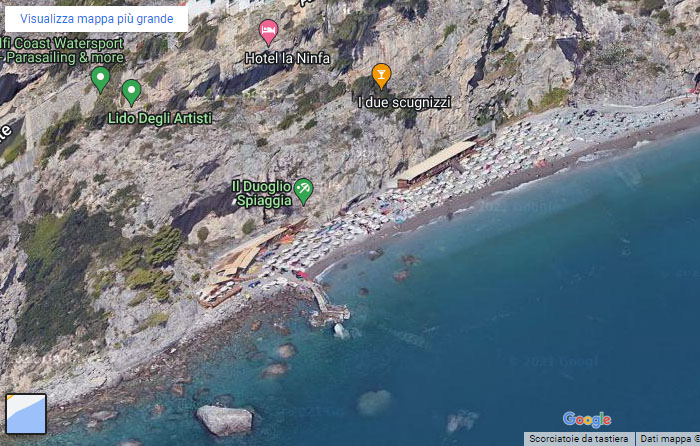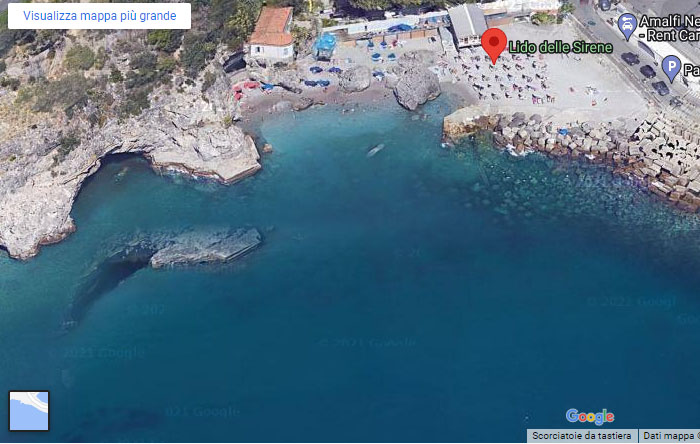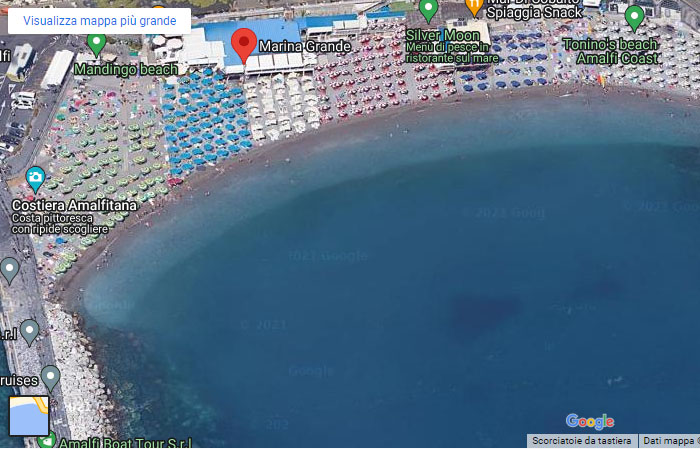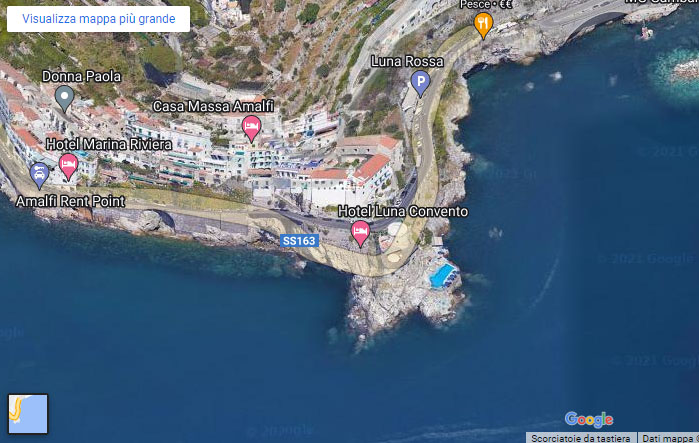FOLLOW US ON:
Amalfi
Amalfi is an internationally known tourist town thanks to its natural beauties and its mild climate. Its history, its landscapes, the sea, the monuments are a wonderful and unique cocktail. Situated between the Lattari mounts, rich of citrus groves, and the sea, Amalfi is the pearl of the coast to which it gives the name.
The town is made of white houses on the rocks, with narrow streets and staircases, and it is situated in the valley of Canneto river. The solar and wonderful nature creates a magic atmosphere.
900 and 1100 Amalfi traded with the most important ports of Mediterranean sea and was a very important Republic. Sailors from Amalfi knew the use of the compass and they had real statutes to regulate navigation that represent an example of the modern law of navigation.
The most important monument in Amalfi is the Cathedral dedicated to Saint Andrew, with the great staircase made of 57 steps, the dreamed destination of all the lovers of the world. The port is the place from where all the excursions to Capri and Sorrent leave. Each four years, in June, the port is the theatre of the traditional boat-race “Regata Storica delle Repubbliche Marinare“, in Middle Ages costumes.
The Museo della Carta (a paper museum) is very interesting, paper is still produced using techniques of XVIII century. During the summer, Amalfi is the reign of entertainment with many events, such as Lemon Festival that celebrates the most famous fruit of its cultivations, the lemon, and the tasteful liqueur, Limoncello. Amalfi Coast.
CIN: IT065006A1TW5S3T5R
CIN: IT065006B4UOUHDPIN
CIN: IT065011B4FUK3BQUQ
CIN: IT065104A1WFAHKS2W
CIN: IT065006B4AMPC9EOE
CIN: IT065006A1BJYRVIHS
Amalfi, Italy, is a stunning destination for travelers looking to explore the rich culture and breathtaking landscapes of the Amalfi Coast.
Amalfi Town, with its charming streets and vibrant atmosphere, is famous for its historic landmarks, especially the Amalfi Cathedral. This remarkable cathedral, dating back to the 9th century, draws visitors for its unique blend of architectural styles and scenic views of the town.
Planning a holiday in Amalfi is made easier with the variety of options available for every budget, from luxurious Amalfi hotels to cozy guesthouses.
The weather in Amalfi is typically mild and warm, making it an ideal spot year-round, though summer months offer perfect beach days and lively festivals. Beyond sightseeing, the town offers delicious dining experiences; Amalfi restaurants serve up authentic Italian cuisine with fresh, local ingredients.
For a memorable Amalfi holiday, visitors can enjoy stunning coastal views, historical sites, and the delicious flavors of Italy in one incredible location.
History of Amalfi
The origin of the town is not a certain one.
The name comes from Latina (from Melfi, a Lucan sea village abandoned by Roman people in IV century a.C. or maybe from Roman gens Amarfia, that lived in I century a.C.).
A legend tells that the name comes from Amalfi, a nymph loved by Hercules. She was buried there as a desire of the gods. Amalfi was surely inhabited by Romans, escaped on Lattari mounts to hide from Germanic and Longobard invasions.
It was a castrum in defence of Byzantine ducat of Naples. The town had a privileged relation to Byzantium thanks to its ability in the commerce.
Amalfi people invented the compass and spread its use in the Mediterranean sea in the first half of XIII century.
The famous “mythic” inventor Flavio Gioia never existed even if a monument in the main square of Amalfi was dedicated to him by an artist from Cava de’ Tirreni, Alfonso Balzico. An ancient Amalfi tradition tells that a man, Giovanni Gioia, was the person who invented the compass.
Sailors from Amalfi were able to manage commercial relations to all the towns of Mediterranean Sea, also to Saracens.
Amalfi has been an Episcopal seat since 596.
On the 1st September 839 Amalfi separated from the Ducat of Naples and became an autonomous town. Longobard princes had always been interested to conquer this rich town, but Amalfi was able to resist.
The small autonomous state was governed by a count, elected each year by representatives from the noble families and then it was governed by a duke. During that period the state covered the area between Cetara and Positano, together with Capri and Li Galli isles, and in the inner part it included also Lattari mounts to Gragnano, near Naples.
This was the best period for Amalfi: this was also the period of the rivalry with Pisa, Genoa and Venice.

Amalfi had its own currency: the tarì.
Commerce was very prosperous and merchants had colonies in many places on the Mediterranean Sea. There was the institution of the maritime law code, too.
It was called Tavola amalfitana (it is kept as a paper copy of XVII century in the Museo Civico).
In 1039 Guaimario V, Prince of Salerno, subdued Amalfi for a short while. Then Roberto il Guiscardo started its domination in Southern Italy. To survive, Amalfi had to ask for its protection and the last duke of Amalfi, Marino Sebaste, was removed. The Pope formed an alliance against Roberto il Guiscardo and the Pisani, that were part of this alliance, in 1135 sacked Amalfi and the near towns.
Amalfitan Coast was now a feud governed by several different noble families. It had lost its wealth and its power.
In 1131 it had been conquered by Ruggiero II, the Norman king. He protected Amalfi and its commerce that represented a very important resource for the Reign of Sicily.
But in 1135 Pisani came again to Amalfi and destroyed it, while its navy was fighting against Saracens. Amalfi commercial power completely declined also because of anti-Byzantine politics of Norman rulers: Amalfi could no more trade with Byzantine towns, but only with the ports of Southern Italy.
During Middle Ages Amalfi had powerful fleets: a military navy and a commercial one. The military one was very strong and defeated many times Arabs, for example in the famous battle of Ostia (849) when Amalfi navy contributed to the defence of Rome against Muslims.
Amalfi built its ships in an arsenal whose ruins still remain. It is now the only survived arsenal in Southern Italy. It was restructured in 1240 and 1272. Commercial ships were built on the beaches, called for that reason with the Byzantine name of “scaria”. In the night between 24th and 25th November there was a terrible landslip that submerged the port. It was provoked by a terrible Libeccio storm.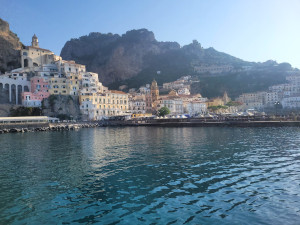
In 1398 Amalfi became a feud of Sanseverino family, then of Colonna, Orsini and Piccolomini families.
In XV century Amalfi was ruled by Aragons and there was the arrival of Catalan merchants that were in competition with the local ones. This was another period of decadence.
In 1643 there was a terrible and cruel plague, a third of the population died. The coast became more and more miserable.
In XVIII century Amalfi was almost uninhabited, the noble families had moved to Naples. But in this period there was the naissance of new handicraft activities: the “centrellari”, that built rivets in Pogerola, the coral-workers, the goldsmiths, the blacksmiths and the “calafati” (the workers that repaired the ships to make them waterproof).
In June 1807 Giuseppe Bonaparte visiting the Coast was enchanted by it and decided to build a road from Naples to Amalfi. The road was completed in 1854 by Ferdinand II.
In 1879 the famous writer Erik Ibsen, walking through the narrow streets of the Coast, had the right inspiration to complete his masterpiece “A Doll’s House”.
In XX century Amalfi became a famous tourist destination, the “Dolce Vita” arrives from Rome to Capri and Amalfi: film directors, artists, actors and actresses came to this Coast.
Monuments – Art
Sant’Andrea Cathedral
- Sant’Andrea Cathedral with a long staircase made of 57 steps and a polychrome facade. The bronze portal was made in Constantinople in XI century. Near the Cathedral there the Crocifisso Church with its Romanic bell tower, built in XII century
- Paradiso cloister, with small crossed arches, it was built in XII century and has a Gothic-Arabic style. It is surrounded by an Arabic portico and there are several archaeological Roman and Middle Ages finds
- The square of the cathedral with a statue dedicated to Saint Andrew
Museums
- Museo della Carta, a paper museum where visitors can see the tools and techniques used to produce paper
- Arsenale della Repubblica, the arsenal of the republic, of Arabic- Norman style, with cross vaults
- Museo dell’arte contadina, with all the tools used for agriculture
- Museo Civico, the civic museum where there are the “Tabula de Amalpha” (the maritime law code) and the “Codice Foscariniano”, a great collection of manuscripts of XVII century together with the costumes of the Regata Storica delle Repubbliche Marinare made in 1950s by the scenographer Scielzo
The five hamlets
The five hamlets (Pogerola, the ancient castle of the town; Pastena, near the walls; Lone, with its cultivated terraces; Vettica Minore, with beaches and caves; Tovere, the highest) .
Churches
- Santa Maria a Piazza o di Porto Salvo church, in Baroque style
- Sant’Eustachio Church of XII century
- San Filippo Neri Church del XII century
- San Giovanni Church with a three-style bell tower: Arabic, Gothic and neo-classical. It has a inique majolica clock
- Madonna del Carmine Church of XVI century
- Annunziata Church in Pontone
Amalfi Coast Beachs
Vettica Minore
Pebbly and rocky beach.
Le Sirene beach
Rocky beach.
Marina Grande di Amalfi
Rocky and sandy beach.
Spiaggia Scogliera
Rocky beach.






